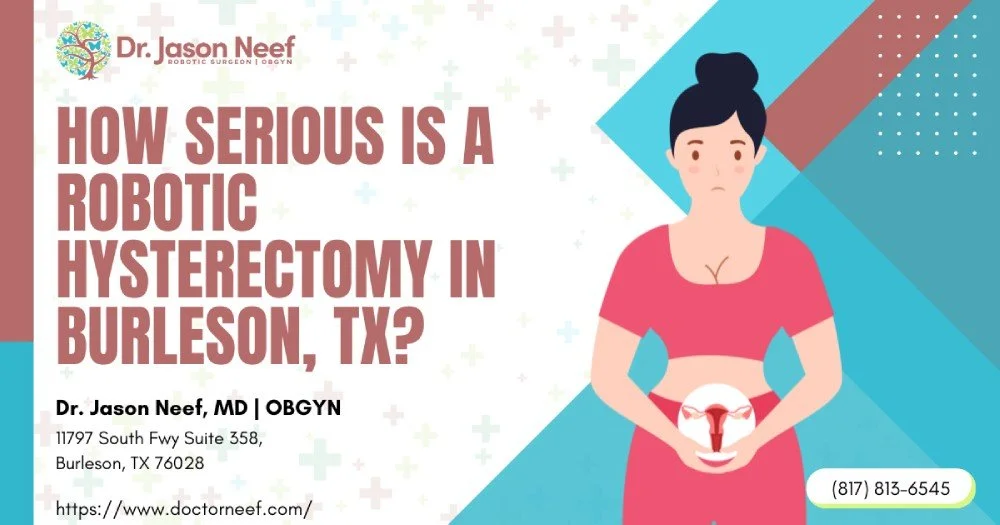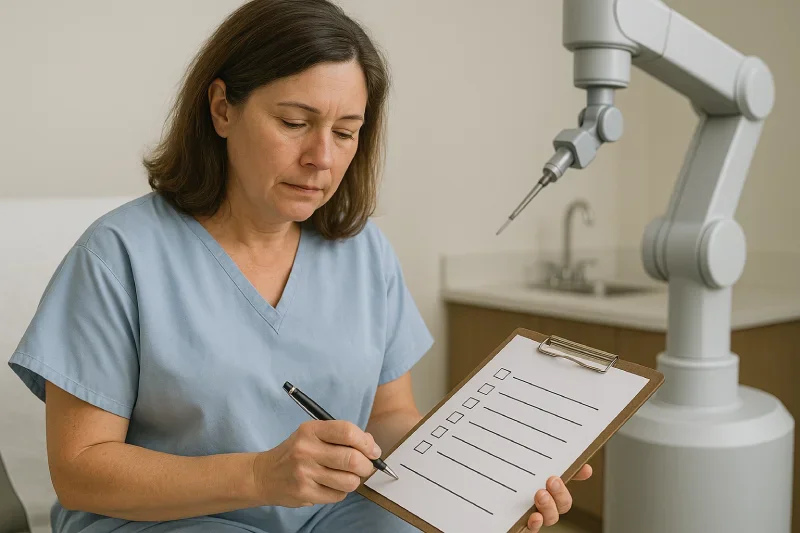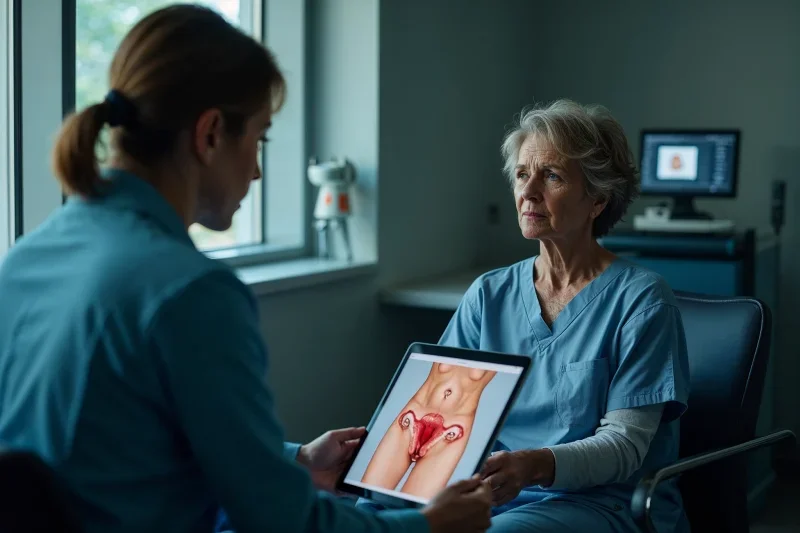How Serious is a Robotic Hysterectomy in Burleson,
Categories:
By: Ethan Cole
Wondering how serious a robotic hysterectomy really is? Living in Burleson or the greater Dallas–Fort Worth area, you’ve probably heard friends praise shorter hospital stays after da Vinci surgery. Yet surgery is surgery, and you deserve a clear answer. A robotic hysterectomy, even though minimally invasive, is still a major gynecologic operation that carries risks—though studies show it is generally safe and effective when performed by an experienced robotic surgeon. Over the next few minutes, we’ll unpack the procedure, risks, benefits, and recovery so you can make a truly informed decision.
Key Takeaways About Robotic-Assisted Surgery
A robotic hysterectomy is major abdominal surgery, but the minimally invasive robotic surgical system typically means smaller incisions, less blood loss, and faster recovery compared to traditional open surgery.
Most North Texas patients return to desk work in two weeks, yet full internal healing still takes six to eight weeks, so respect lifting, sex, and exercise restrictions.
Complications such as bladder or bowel injury are rare; choosing a Burleson or Fort Worth surgeon like Dr. Jason Neef—who performs at least 30 robotic hysterectomies per year—improves surgical outcomes.
Insurance usually covers medically necessary hysterectomies, including those performed with the da Vinci robotic system, but always confirm facility fees to avoid surprise costs.
Walking daily, staying hydrated, eating protein, and leaning on local support groups accelerates recovery and reduces pain.
Robotic Surgical System Basics: Why “Robot-Assisted” Doesn’t Mean “Robot-Operated”
Robotic hysterectomy relies on computer-enhanced technology that gives your surgeon—seated at a console—tremendous precision. Think of it as power steering for surgery rather than autopilot. The surgeon’s hand, wrist, and finger movements are mirrored by robotic arms that hold pencil-thin instruments, translating large external motions into microsurgical movements the size of a dime inside your abdomen.
The da Vinci Xi Platform Used in Burleson and Fort Worth
Hospitals such as Texas Health Huguley, Baylor Scott & White All Saints, and North Texas Surgical Specialists’ partner facilities employ the da Vinci Xi minimally invasive robotic surgical system. A high-definition 3-D camera magnifies pelvic anatomy tenfold, giving Dr. Jason Neef an unparalleled view while he controls four robotic arms. The result? Cleaner dissection, less bleeding, and often less postoperative pain compared with conventional laparoscopic surgery.
Capabilities of the Robotic Arms
Rotation up to 540°—far beyond the human wrist—enables suturing deep in the pelvis.
Tremor filtration removes tiny hand shakes, yielding greater surgical precision.
Dual-console options allow a teaching surgeon to oversee a resident without compromising safety.
Comparing Surgical Approaches: Robotic Laparoscopic vs. Traditional Open Surgery
Choosing the right type of surgery requires weighing incision size, blood loss, scarring, and recovery times.
|
Surgical Approach |
Incision Length |
Average Blood Loss |
Hospital Stay |
Return to Normal Activity |
Visible Scarring |
|
Traditional Open Surgery |
5–7 inches |
400–600 mL |
2–3 days |
6–8 weeks |
Prominent |
|
Conventional Laparoscopic |
0.5–1 inch (3–4 ports) |
150–250 mL |
1 day |
3–4 weeks |
Minimal |
|
Vaginal |
No skin incision |
200–300 mL |
1–2 days |
4–6 weeks |
None |
|
Robotic-Assisted Laparoscopic |
0.5–1 inch (4–5 ports) |
100–200 mL |
Same day or overnight |
2–3 weeks |
Minimal |
Benefits of Robotic Surgery
Robotic surgery offers:
Smaller incisions = less scarring and usually less pain medication
Lower conversion rates to open surgery
Shorter hospital stays and quicker return to work
Potential for better preservation of pelvic nerves and bladder function
When Open or Vaginal Hysterectomy May Be Better
A uterus larger than 16 weeks’ pregnancy size, extensive endometriosis, or suspected cancer spread can require open abdominal surgery. Conversely, a small prolapsed uterus may be removed fastest by a vaginal approach. Your Burleson surgeon will match technique to diagnosis, anatomy, and personal goals.
Potential Risks and Complications of Minimally Invasive Robotic Surgery
Even with advanced robotic equipment, any invasive surgery carries risk.
Common, Expected Side Effects
Mild vaginal spotting for six weeks
Shoulder pain from the CO₂ gas used to inflate the abdomen
Temporary urinary urgency
Less Common but Serious Risks
Infection at the port sites or within the pelvis
Organ injury (bladder, ureter, or bowel)
Deep-vein thrombosis or pulmonary embolism
Rare need to convert to open surgery due to bleeding or dense adhesions
Promptly call your provider if you develop fever over 101 °F, heavy bleeding, worsening abdominal pain, leg swelling, or shortness of breath.
The Patient Journey in Burleson & Fort Worth, TX
Knowing each step—from consultation to the last post-op visit—makes the process less intimidating.
1. Consultation and Insurance Authorization
During your initial visit, Dr. Jason Neef reviews imaging, labs, and prior surgical history. Bring your insurance card; most carriers reimburse robotic-assisted surgeries the same as open procedures, but facility and anesthesia fees vary.
2. Pre-Operative Preparation
Lab work, EKG, and sometimes colon and rectal screening if you’re over 45
Review of medications; you may need to stop blood thinners
Bowel prep is less common now, but your surgeon may still recommend a mild laxative to reduce contamination risk.
3. Day of Surgery
Arrive two hours early. After anesthesia assessment, you’ll receive general anesthesia and a urinary catheter. The da Vinci robotic system is docked once small incisions—each the size of a fingertip—are placed. Average operative time in Fort Worth is 90–120 minutes. Most patients go home same day; some stay overnight for pain control or observation.
4. Week-by-Week Recovery
Days 0–3: Walk every few hours, drink fluids, start a stool softener.
Week 1: Light meals, avoid lifting over 10 lbs. Shower; do not soak incisions.
Week 2: Many patients drive and return to desk work.
Weeks 3–4: Gentle yoga or stationary bike if cleared.
Weeks 5–6: Resume intercourse, swimming, and moderate exercise once your surgeon confirms healing.
Week 8: Full activities, including high-impact workouts and heavier lifting.
Optimizing Recovery After a Robotic Hysterectomy
Small daily choices influence how fast you feel like yourself again.
Move Smart
Walking boosts circulation and lowers clot risk. Set a phone alarm every two hours during waking hours. Avoid crunches or heavy lifting until cleared.
Fuel Healing
Aim for 60–80 g of protein daily through Greek yogurt, eggs, or plant-based shakes. Combine protein with fiber-rich veggies and at least two liters of water to combat constipation common after anesthesia and narcotics.
Protect Emotional Health
Hormone changes and physical discomfort can trigger mood swings. Join the Women’s Health & Wellness Support Group at the Burleson Senior Activity Center or online forums like HysterSisters. If low mood persists, ask your provider for a counseling referral.
Choosing the Right Robotic Surgeon in North Texas
Skill and bedside manner differ among surgeons, even when they use the same robotic system.
Credentials to Prioritize
Board-certified OB/GYN or gynecologic surgeon
Fellowship training in minimally invasive gynecological surgery
Performs at least 30 robotic hysterectomies annually
Low conversion-to-open rate and excellent infection statistics
Smart Questions to Ask Dr. Jason Neef
How will my uterine fibroids or endometriosis affect surgical complexity?
What strategies do you use to reduce blood loss and adhesions?
Who covers your patients after hours?
Which supplies should I buy for home recovery—abdominal binder, heating pad, or lounge pillows?
Taking notes—or bringing a friend—ensures you capture every detail.
Final Thoughts
A robotic-assisted laparoscopic hysterectomy blends cutting-edge technology with skilled human hands. Smaller incisions, less pain, and faster recovery make the da Vinci minimally invasive robotic surgical system appealing, but it remains major surgery. Understanding the full spectrum of benefits and risks, selecting a high-volume surgeon, planning financially, and following post-op guidelines help you recover faster and safer. Ready to explore whether robotic surgery is right for you? Schedule a consultation with Dr. Jason Neef and the team at North Texas Surgical Specialists today.
Schedule a personalized Essure consult with Dr. Neef today.
Call (817) 568-8731Categories:
Frequently Asked Questions
-
While both procedures use small incisions, robotic arms give the surgeon wrist-like dexterity and 3-D vision. This enhanced control can improve suturing around delicate structures, potentially reducing blood loss and lowering the chance of converting to traditional open surgery.
-
Yes. For many women with symptomatic uterine fibroids, robotic hysterectomy is safe and effective. The precise dissection offered by the da Vinci system helps remove the uterus while minimizing trauma to surrounding tissue, often resulting in less pain and faster recovery compared to open surgery.
-
Most patients go home the same day. However, if you have medical conditions such as sleep apnea, uncontrolled diabetes, or significant bleeding during the procedure, your surgeon may recommend one overnight stay for monitoring.
-
No. In addition to tiny incisions and reduced scarring, patients typically experience less postoperative pain, lower infection rates, quicker return to normal activity, and shorter hospital stays—all of which contribute to improved quality of life and satisfaction.
-
Expect restrictions on lifting anything heavier than a gallon of milk, driving while on narcotics, and strenuous exercise. Light walking around the house is encouraged to boost circulation and aid healing, but avoid core-strengthening workouts until cleared at your post-op visit.
-
The robotic arms securely grip custom-designed surgical tools, each capable of rotating and articulating beyond the human wrist. These controlled movements are directed in real time by the surgeon at the console, translating hand motions into scaled-down, precise actions inside your abdomen.
-
Absolutely. Surgeons in the Dallas-Fort Worth region frequently use robotic systems for myomectomy, endometriosis excision, sacrocolpopexy for prolapse, and even certain colon and rectal procedures. The same benefits of smaller incisions and faster recovery generally apply.
-
Facility and equipment fees can be higher, but shorter hospital stays and quicker returns to work may offset initial costs. Most insurance companies, including those in North Texas, cover robotic procedures when deemed medically necessary, so your out-of-pocket expense may be similar.
-
Dr. Neef adopted robotic techniques in 2012 and now performs more than 60 robotic gynecologic procedures annually. His decade of experience contributes to low complication rates and high patient satisfaction scores in Burleson and Fort Worth.
-
If bleeding or unexpected anatomy makes robotic continuation unsafe, the surgeon may convert to conventional laparoscopy or traditional open surgery. This decision is made in real time to prioritize safety and ensure the best possible surgical outcomes.













